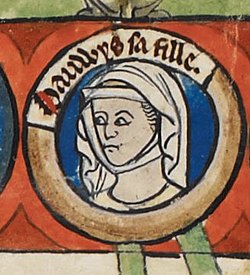Life
Hawise was the daughter of Richard I of Normandy and Gunnor, and was sister of Richard II "the Good", Duke of Normandy as well as Robert, Archbishop of Rouen, Count of Evreux. [1]
Regency
In 1008 when Geoffrey died leaving two young sons, Alan III and Eudo, Richard stepped in to protect them and played a major role in governing Brittany during their minority. [3]
Hawise acted as regent of Brittany during the minority of her son Alan III. [4] In 1010 her regency and the reign of her young son Alan III was seriously challenged by the peasant revolts that had spread from Normandy into Brittany. Alan, encouraged by his mother, led the nobles to quash the rebellion. [5]
Hawise died on 21 February 1034. [6]
This page is based on this
Wikipedia article Text is available under the
CC BY-SA 4.0 license; additional terms may apply.
Images, videos and audio are available under their respective licenses.
